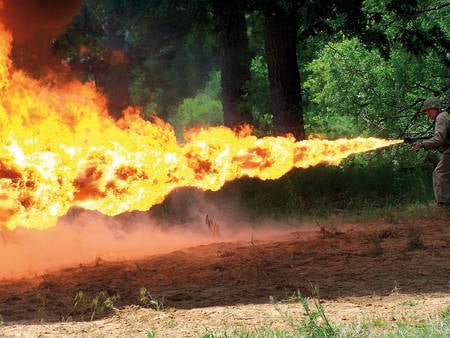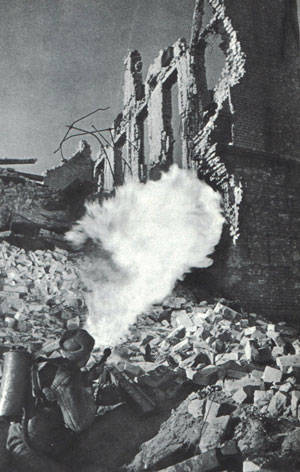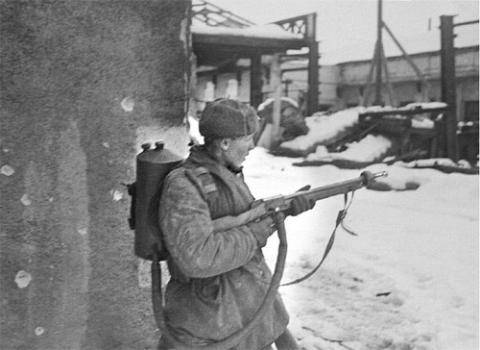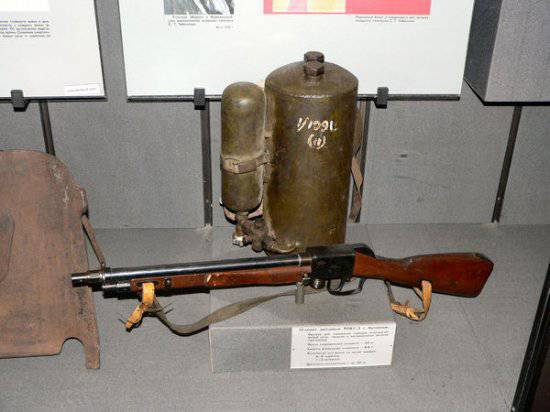Belching flames

The current story is about two types of jet flamethrowers: wearable backpack and stationary high-explosive.
The main "component" of the flamethrower is, of course, the incendiary substance itself, which it is equipped with. Until 1940, liquid fire mixture was used, which included 25% gasoline, 25% kerosene and 50% engine oil. She had all the disadvantages of low viscosity mixtures - the flame throwing range was no more than 30 m (that is, the flamethrower should have approached the enemy at a grenade throw distance), a significant part of the mixture burned in flight, not reaching the target, and some - albeit insignificant - fell on land in front of a flamethrower.
True, there were liquid mixtures and advantages - ease of preparation, availability of raw materials, stability during storage, easy flammability at low temperatures, the ability to give a flame with a flame jet, which envelops the object and has a demoralizing effect on enemy soldiers. (“All living things are afraid of fire” - the truth has long been well known.) Nevertheless, the urgent need to increase the range and effectiveness of flame throwing required more viscous mixtures.
For the preparation of viscous mixtures need thickeners. The curing powder OP-2 A. Ionova was used as the last one. Viscous fire mixtures were composed of various grades of gasoline, HGS liquid and OP-2 powder, diesel oil: one of the options contained 88 – 91% automobile gasoline, 5 – 7% solar oil and 4 – 5% OP-2 powder, the other - 65 gasoline, according to 16 – 17% liquid BGS and oil, 1 – 2% ОP-2. In addition to increasing the range of flame throwing and burning time, these mixtures also differed by better adhesion to surfaces. The Scientific Research Institute-6 of the People's Commissariat for Ammunition conducted experiments on the equipment of flame throwers with mixtures of fuel with a self-igniting liquid CS, but their use required complex technical solutions and they were not used in production samples. In the absence of viscous mixtures in the troops, they were engaged in the manufacture of liquid, for example, mixtures of fuel oil, kerosene, and gasoline.
ROKS and FOGI
By the beginning of World War II, the RKKA had a backpack-type flame-throwers, ROX-1 and ROX-2 (a Klyuev-Sergeev backpack-flamethrower) of sample 1940 of the year. Each of them consisted of a tank with fire mixture (made in the form of a knapsack), a cylinder with compressed gas, a gun-hose connected to the tank with a flexible hose and equipped with an automatically acting igniter, and a belt hanger. The ROKS-2 tank contained 10 – 11 l of fire mixture, the range of flame throwing with a viscous mixture reached 30 – 35 m, liquid - up to 15 m.
 In the 1942 year, Klyuev and Sergeev, who worked at the plant No. 846 of the People's Commissariat of Weapons, designed the ROX-3 flamethrower with a cylindrical tank, a reduced gun-gun, and improved sealing. 10 fireplaces were calculated for 6 – 8 short (up to 1 seconds) or 2 – 3 long (3 – 4 seconds) shots. Flame throwing range viscous fire mixture - up to 40 m (with a fair wind - 42 m).
In the 1942 year, Klyuev and Sergeev, who worked at the plant No. 846 of the People's Commissariat of Weapons, designed the ROX-3 flamethrower with a cylindrical tank, a reduced gun-gun, and improved sealing. 10 fireplaces were calculated for 6 – 8 short (up to 1 seconds) or 2 – 3 long (3 – 4 seconds) shots. Flame throwing range viscous fire mixture - up to 40 m (with a fair wind - 42 m). ROX-3 acted as follows: the compressed air in the cylinder under the pressure of 150 atm was fed to the gearbox, where its pressure was reduced to working 17 atm. Through the non-return valve, air passed through the tube into the tank, and under its pressure, it mixed fire through the suction tube and flexible hose into the valve box. At the initial pressing of the trigger of the gun, the exhaust valve opened and the portion of the fire mixture was fed through the hose to the hose. On the way she passed through a damper, extinguishing the spiral vortices arising in the mixture. With further pressure on the hook, an incendiary device at the end of the fire engine worked, its flame ignited the jet. The ROX-3 incendiary device contained a drum on 10 idle igniter cartridges made on the basis of the “Nagan's” liner, and a percussion mechanism. The pyrotechnic lighter made it possible to do without electric circuits, but in field conditions the idle cartridge often became damp. Yes, and rubber hoses with insufficient rubber resistance cracked or swelled. So ROKS-3, although it was more reliable than its predecessors, still demanded a careful attitude and very thorough care. Rox-3 combat checks were conducted during the Battle of Stalingrad.
By the resolution of the State Defense Committee of 12 in July 1941, the stationary no-piston high-explosive flamethrower FOG-1 was used, intended primarily to strengthen the anti-tank defense, as well as to create a fire curtain on the approaches to the positions, to cover the wings and seams.

In high-explosive flamethrowers, the throwing of the fire mixture is produced by the pressure of the powder gases of the expelling powder charge. This allows you to increase the range of release and jet power, but you have to pay with cumbersomeness and the need to bring the flamethrower into action remotely.
FOG-1 had a removable hose, gunpowder charge and incendiary bomb with separate electrosports. Charging is designed for one shot lasting about 2 with. The flamethrower was installed in the position in the hole, fixed with pegs, masked, put into action by applying current from a blasting machine or battery.
The FOG-2 flamethrower, which was put into service in 1942, was more compact, primarily due to the shortening of the hose, gave a range of flamethrowing from 25 to 100 – 110 m to a viscous mixture and to 45 – 60 m - liquid. The charge of pyroxylin powder and an incendiary checker with a single electric fuse were placed in a single glass in the upper part of the tank. Through the holes of the glass, the powder gases entered the tank and pushed the fire mixture through the siphon tube and the hose. When the pressure reached 20 – 40 atm, the membrane was cut off at the outlet of the hose of the hose, fired the mixture out of the flamethrower, igniting at the exit with the flame of an incendiary checker. Since electric cables were often torn, electric ignition was duplicated by powder cartridge and percussion mechanism. And often the flamethrower had to pop out of the trench near the position of the flamethrowers and just hit the drummer with a sapper shovel. In 1944, the FOG-2, instead of such a device, was equipped with a fuse of type МУВ, used in engineering ammunition, - it could be pulled out with a wire or cord.
According to the properties of flamethrowers, the tactics and organization of flamethrower subunits and units differed. And according to notation weapons they were divided into "Roxists" and "Fogists".
On the eve of war, platoons of backpack flame-throwers were part of the chemical companies of rifle divisions. By order of the People's Commissar of Defense I. V. Stalin of 13 in August 1941, flamethrower units were transferred to the rifle regiments as individual teams. But in the fall, separate companies of backpack flame throwers (orro) were formed. Statewide from June 1942, each orro was equipped with 120 flamethrowers.
As expected before the Great Patriotic War, knapsack flamethrowers proved effective in the combat formations of the infantry. The Directive of the Main Military Chemical Directorate of 27 of September 1942 of the year provided for the use of backpack flamethrowers in defense (with an approximate saturation of 1 – 2 platooning flamethrowers on the infantry regiment), counterattacking and assault groups, garrisons of bunkers and bunkers.
As part of the 39-th Guards Rifle Division in Stalingrad, during the battles for the Red October plant, for example, the 171-I separate troop of flamethrowers operated. For 3 – 5, flamethrowers were given to assault groups that had the task of taking active actions, mostly at night, to harass and destroy the enemy in factory buildings. Typically, flamethrowers secretively, crawling to the positions of the Nazis and made flamethrowing through the embrasures of the enemy firing points. After that, they threw grenades and engaged infantrymen. From 4 to 26 in November, we managed to deal with 25 firing points in such a way, which allowed us to capture and hold five factory buildings.
It is worth noting that under fire of the enemy, the flamethrower risked more than the usual infantryman: in any position he was a big target, any hit of a bullet or a fragment in the tank or hose could turn it into a living torch. And the enemy soldiers specially hunted for flamethrowers, realizing the threat they pose. This made the stealth and cover-up of flame-throwers by infantrymen especially important.
Orros were introduced into the engineering and sapper assault battalions. And in the middle of 1943, the integration of flamethrowing units began, in particular, separate battalions of backpack flame throwers (Obro) were formed. In May, 1944-o-gangs are included in the assault engineering-sapper brigades. The battalion of the state had two companies of 120 ROXs each.
In August, 1941, the decision was made to form individual mouths of high-explosive flame throwers (orfo). From October 1941 to January 1942 in the troops created 143 such companies on horseback. Soon, however, for greater mobility, horses were replaced by cars, and the number of flamethrowers in the company decreased from 180 to 135 units.
In defense, FOGs were initially positioned linearly at the junctions of rifle units in tank-dangerous directions. At the same time, the effect of the use of flamethrowers is, in any case, against tanks - was usually quite limited. Nevertheless, the 26th Orfo under the command of Lieutenant M.S.Sobitsky on December 1, 1941 north of Naro-Fominsk destroyed four tanks and up to two enemy infantry companies - this incident was noted by the commander of the Western Front G.K. Zhukov in order No. 075 of December 8, 1941.
The main military chemical department in August 1942 recommended to equip the positions of high-explosive flamethrowers concentratedly in the form of “flame-throwing bushes” with a decrease in the intervals along the front and separation in depth. This corresponded to the general direction of creating a layered anti-tank defense and increasing the density of anti-tank weapons in the most important tank-dangerous areas. The flamethrower unit (6 man, 16 FOG) was located in the defense of three “bushes” - each pair of fighters installed 5 – 6 FOGs, directing them to different sectors. "Bushes" were covered with machine gunners. Orfo was thus positioned 1 – 1,2 km along the front and 200 – 300 m in depth. Usually, enemy tanks were let in on 60 – 80 m, then flamethrowing was carried out in groups.
In the first military winter, FOGIs were sometimes made “mobile”, placing them on sleds or scraps, and used in offensive battles. Later, they began to pull up on self-made wheelchairs to secure the captured positions and repel the enemy’s counterattacks (such an application took place, for example, in the defensive battle near Stalingrad).
In the summer of 1943, separate motorized anti-tank flamethrower battalions were created (companions, each battalion had 540 FOGs) and separate flame-thrower battalions (ob, 576 FOGs). They were listed in the reserve of the Supreme Command Headquarters and were attached to major fronts during large-scale operations. There they were usually distributed along rifle compounds. The companies and platoons of high-explosive flamethrowers were introduced into the battle formations of rifle units and anti-tank artillery units. 5 July 1943, in the area of Maloarkhangelsk, the 410 Infantry Regiment of the 81 Infantry Division was able to retain its advanced positions thanks to the skillful use of high-explosive flamethrowers attached to the 2 Battalion. Flame-throwing, anti-tank weapons and infantry anti-tank weapons were destroyed and burned 57 enemy tanks.
Independent actions of flamethrowers with weak support by infantry and artillery gave the worst result. Thus, 4 th commander under the command of captain V.V. Kostyuchenko during 9 – 11 in October 1943, bravely defended the bridgehead on the right bank of the Dnieper near the village of Shchuchinka, repelling the attacks of the tanks and infantry of the Nazis, and did not allow the enemy to break through to the crossings. Having occupied a three-kilometer-wide defense sector, the battalion installed 246 FOGS. Our soldiers managed to restrain the onslaught of the enemy, but his tanks, taking advantage of the lack of anti-tank guns and shotguns, shot the detected positions of flamethrower with a safe removal. Already in the morning of October 9, the battalion's 3 company lost about 40% of its personnel, and the 2 company dropped to 50%. In the afternoon, the enemy managed to push back flamethrowers, but they continued to hold on to the new frontier. By the way, the fear of the German infantry of powerful flamethrowers clearly prevented her from interacting with the tanks.
Lieutenant-General G. G. Semenov described the use of the 13-th separate flamethrower battalion of Major P.A. Gaidai to strengthen the defense of the 21-th Guards Rifle Division in October 1943: “The combat orders of flame-throwers were located mainly at the junctions between the battalions and regiments, which covered the approaches to the city from the west, southwest, and northwest. For several days, the infantry and flamethrowers combined efforts to beat off the numerous attacks of the enemy. Jets of flame escaping from flamethrowers, not only burned the enemy soldiers and equipment, but also acted on the psyche of the advancing fascists. Especially in the dark. "
Impact on the enemy with powerful volleys of high-explosive flamethrowers helped prepare the attack. For example, on the night of 3 December 3 of the year, they secretly approached the positions of the enemy, installed them in 35 – 5 from the front edge of the 1943 of the FOGs and brought them to 50 – 60 from the front edge of the 50 of the FOGs. action immediately before an infantry roll. The physical and moral impact of the volley on the enemy made it possible to take advanced trenches with almost no losses. At the time of the Budapest operation, the 5 Division supported the 214 Guards Rifle Regiment of the 73 Guards Rifle Division 19 and 20 in November 1944 on the banks of the Danube in the Batin area. Flamethrowers installed FOGIs on the 1100 – 1200 front approximately m 100 meters from the enemy’s advanced positions and fired a volley at the end of the artillery preparation. The enemy threw trenches, and our troops occupied them. True, there have been cases when their own infantry, not warned in advance, unfamiliar with this type of weapon and shocked by its action, themselves lay down or even retreated.
As for fighting the enemy’s tanks, if necessary, they also attracted backpack flame-throwers. The Roxists usually let armored vehicles on 20 – 30 m and fired on one of them 3 – 6 flamethrowers. When repelling tank attacks with infantry, salvo flame throwing was practiced - like salvoes of high-explosive flamethrowers. In the settlements, “flamethrowing ambushes” as part of 2 – 3 ROXs on the second floors of buildings turned out to be effective. When using fast-burning mixtures for greater reliability, the first flamethrower often released a mixture of non-flammable to the tank, and the second set fire to it with a burning jet - this way more fire mixture fell on the tank.
In fortified areas and cities
Flamethrowers were indispensable in the assault on long-term fortifications and in urban battles. Often they played a decisive role in the success of rifle units. Thus, the 3 and 27 th separate flamethrower battalions actively participated in the capture of Miskolc (Hungary), being attached to the 104 rifle corps of the 27 army. 1 December 1944, a fire group with 4 high-explosive and 2 knapsack flamethrowers, approached the enemy's stronghold and a strong fire caused them to fire. The enemy soldiers, who fled the enemy soldiers, were destroyed by automatic fire.
Flamethrowers played an increasing role in the assault squads and groups. As a rule, a company of backpack flame throwers was attached to a rifle regiment or operated as part of an assault engineering battalion. Flame throwers tried to reinforce the units that captured the most important strong points and fortified buildings. They acted in groups in close cooperation with the infantry and the sappers. The crushing limit of flame-throwing units during a battle in the city on the 2-th Ukrainian front, for example, was set in 3 – 5 flame-throwers, who were given as many machine gunners for cover. Flame throwers with knapsack flamethrowers not only blinded and demoralized the enemy before the attack, but also accompanied the assault team during the battle, moving with it along the aisles and floors to burn the enemy.
The instructions of the 8 Commander of the Guards Army, Colonel-General V.I. Chuikov from February 18 of 1945, to seize and block buildings turned into strong points, said: “The storming groups ... bombard the attacked object with hand grenades, termite swords and backpack flame throwers the enemy’s garrison is burned through the windows and, having broken into the building, they destroy the defenders of this garrison. ” In the Summary of Generalized Battle Experience, the same army described the following episode during the capture of Berlin: “Strong machine-gun fire and faustpatronami from the Anhalt station and fortified houses in Mekkern and Bergerstrasse ... delayed the advance of two advancing rifle regiments. The fire platoons assigned to the regiments installed 6 FOGS in the direction of the station, 6 FOGS on Mekkernstrasse south of the station and 12 FOGS on the west side of Bergerstrasse west of the station. Undermining the flamethrower was created several fires. The enemy garrison, defending the station, hiding in basements, continued to resist. The arrows and flamethrowers who burst into the station made four breaks in the floor. Poured in a fire mix of 4 FOGS and lit it. The enemy’s garrison was completely destroyed. ”
Results
According to official data, during the war, as a result of the use of backpack flamethrowers, the enemy lost 120 tanks, killed around 33 thousands of enemy soldiers and officers, suppressed and burned to 3000 defensive structures and 2300 fortified buildings, about 19 thousands of soldiers and officers were destroyed by fire, high-explosive flame throwers were destroyed struck 362 tank and armored vehicles, 220 vehicles, 1468 firing points.
One can judge how important the improvement of the flamethrower and incendiary weapon was and what significance it has been given by the fact that it was in 1941 – 1945 that the in-depth theoretical work was carried out in the field of flame throwing. And they attracted leading scientists such as academicians L. D. Landau, N. N. Semenov, P. A. Rehbinder. Several scientific groups were involved in the compilation of fire mixtures: the Scientific Research Institute-6, the laboratory of the All-Russian Scientific Research Institute for Oil and Gas Processing, the laboratory of the Neftegaz plant, and the Moscow group of the All-Union Electrotechnical Institute. The achievements of the war period and the rich combat and production experience served to further develop flame-incendiary weapons.

Information